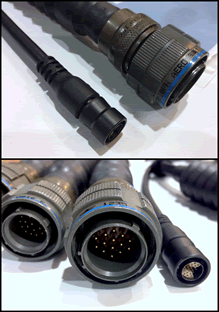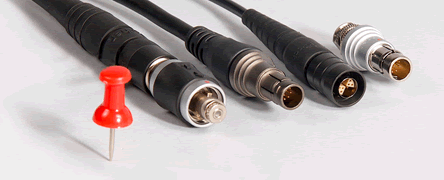Military Connector Miniaturization
Leveraging Pin Density to Reduce Size and Weight
Wim Vanheertum, Product Manager, Miniaturization & Military Applications, Fischer Connectors
The push to make military equipment lighter and smaller is so visible that the writers of the award-winning, nerd-friendly sitcom The Big Bang Theory named a September 2016 episode “The Military Miniaturization.” The story continued several weeks later when fictional Air Force Colonel Richard Williams abruptly demanded that the guidance system Leonard, Howard, and Sheldon were working on be made even smaller. This new miniaturization demand was based solely on a theory that Sheldon had scribbled on a whiteboard, and despite the fact that the previous specifications were already approved, which I’m told isn’t too far from the difficult reality our military engineers face every day. So, I can’t wait to see how the story plays out.
In real life, military organizations work with component manufacturers to achieve aggressive size reductions required to make devices lighter and diminish the amount of power they need. For instance, U.S. Army Armament Research, Development, and Engineering Center (ARDEC) engineers, are promoting advancements in their Component Miniaturization initiative designed to make armament systems more precise, energy efficient, and effective by reducing the size of critical components. And yes, connectors can and do play an important role.
Pin Density and its Impact on Connector Size
We all know about the efforts to reduce the weight that each soldier must carry. Militaries and their prime contractors consistently challenge engineers to shrink the physical size and weight of components, but they don’t accept reduced functionality. Innovative connector manufacturers have answered these challenges by developing highly functional connectors and cable assemblies that not only reduce size by up to 45% compared with older connector solutions, but that also add functionality instead of letting the component’s smaller size limit it.

Figure 1: New miniature, high pin density connectors compared to standard 38999 connectors.
This is where pin density comes into play. To make connectors smaller without reducing functionality, the biggest innovations depend on how pin density is managed. At Fischer Connectors, we define density factor as the diameter of the receptacle divided by the maximum number of contacts available for that receptacle size. Companies continue to align pins in unique, sometimes hermaphroditic configurations, using the right materials to keep interference to a minimum. We don’t like to give away too many secrets, but inspiration comes from a variety of industries. If you’re evaluating connectors, look for a density factor of less than 1.0, which we’ve achieved in our Fischer MiniMax™ Series.
Amperage is another thing to consider when evaluating a smaller connector for pin density. Look at the actual size of the contacts to make sure they can run the required amperage. Every company does miniaturization and density a little differently, and functionality can vary even between product lines from the same company. To ensure the contact size can handle the amperage without interference, ask detailed questions and, if you still aren’t 100% sure, run tests both with and without cable.
It’s also important to evaluate connector shell sizes for usability, as going too small could lead to serious problems for soldiers. Many small, commercially available connectors are too fragile for soldier use, and especially for critical, harsh environment applications, and others are simply too small to be handled with gloves. The key to selecting the right sized connector often comes down to closely examining the density of the pins and the various small and lightweight features designed to protect it from interference.
Does Miniaturization Mean the end of 38999?
Manufacturers have recently made strides toward creating small connectors with a large number of pins that function optimally without interference. Designing in a connector with a low pin density factor drives a number of things, including smaller devices, but it also means that engineers have the freedom to design out some of the larger connectors, such as the heavy, but still very popular 38999.
Military designers who had to achieve many functions with a single connector used to gravitate to the 38999, but in today’s Army, Navy, and Air Force, where the focus is on reducing size and weight, using even a couple of smaller, denser connectors can reduce footprint space by half. It’s simple geometry, especially if the application doesn’t require the use every single contact. So, although it isn’t yet the end for these connectors, the days of huge, heavy 38999 connectors are now numbered due to newer, smaller, lighter, and more capable connector technologies.
There are definitely still applications in which the 38999 will survive, but if you have one in your design and haven’t considered other options, you’re likely overlooking a relatively easy, effective way to modernize your application.
Cable Selection is Another key to Selection Success
With miniaturization comes the challenge of making sure that both the connector and full cable assembly minimize interference. The last thing you want is a smaller device that can’t transmit signals or power clearly and consistently. So, be careful to evaluate the newest miniature connectors in that light. Some connectors are so small that you have to source new cable, and even develop new soldering and crimping techniques. As such, it’s not uncommon to run into manufacturers who won’t even sell you their smallest connectors without a cable because the assembly challenges are all but insurmountable without it.
Data Transfer
We can’t talk about any connector solution these days without talking about the increasing demand for both power and secure data transfer speeds. Military considerations for miniaturization include the ability to move data quickly and without interference. Since connectors, cables, and assemblies affect data transfer speeds, it’s critically important to allow enough time to test connector and cable combinations to ensure that they’re able to achieve the data speeds you need. As connectors get smaller, cable selection gets trickier due to size and assembly restrictions. Suppliers should provide evidence of achieving certain data speeds and supporting specific protocols such as USB, Ethernet, or HDMI, and should also suggest appropriate cable designs or offer fully assembled connector and cable solutions.

Figure 2: Miniaturization efforts extend from electric/copper connectors to rugged fiber optic connectors to help designers reduce both the size and weight of end products.
Let’s Wrap it up
From one product manager to another, keep it simple when you’re looking for that next miniature military connector, and remember that smaller doesn’t have to mean less functionality. Take a look at the pin density factor by dividing the receptacle diameter by the maximum number of pins, and then double-check the contact size to make sure the connector can handle the signal and power you need to run. If the connector passes that test, review it for ruggedness in the field, and find out whether it can be handled with gloves if necessary. Lastly, take the time to ensure that the cable you selected will achieve the data transfer speeds you need. If you follow these few simple recommendations, your device, machine, robot, or vehicle will run as expected and have smaller physical dimensions, which means that both the soldiers and the brass will be happy with your connector selection.
Recently posted:
[related_posts limit=”10″]






